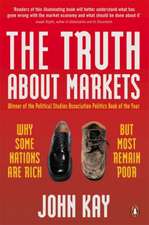The Contribution of Human Capital towards Economic Growth in China
Autor John Joshuaen Limba Engleză Hardback – 27 iul 2015
Preț: 643.84 lei
Preț vechi: 757.46 lei
-15% Nou
Puncte Express: 966
Preț estimativ în valută:
123.20€ • 131.74$ • 102.72£
123.20€ • 131.74$ • 102.72£
Carte tipărită la comandă
Livrare economică 18 aprilie-02 mai
Preluare comenzi: 021 569.72.76
Specificații
ISBN-13: 9781137529350
ISBN-10: 1137529350
Pagini: 301
Ilustrații: XIV, 301 p.
Dimensiuni: 140 x 216 x 19 mm
Greutate: 0.51 kg
Ediția:1st ed. 2015
Editura: Palgrave Macmillan UK
Colecția Palgrave Macmillan
Locul publicării:London, United Kingdom
ISBN-10: 1137529350
Pagini: 301
Ilustrații: XIV, 301 p.
Dimensiuni: 140 x 216 x 19 mm
Greutate: 0.51 kg
Ediția:1st ed. 2015
Editura: Palgrave Macmillan UK
Colecția Palgrave Macmillan
Locul publicării:London, United Kingdom
Cuprins
Introduction
(i) Structural Transformational Growth and the
Transformation of Human Capital
(ii) Uneven Structural Transformation between
Chinese Provinces
(iii) Aims of the Thesis
(iv) Outline of the Study
Chapter 1
Neoclassical and Endogenous Growth Models
(i) A Comparative Analysis of Neoclassical and
Endogenous Growth Theories
(a) The Harrod-Domar Theory of Economic Growth
(b) The Neoclassical Model of Economic Growth
(c) The Endogenous Growth Model
(ii) Human Capital and the Endogenous Nature of
Technological Change
(iii) Endogenous and Exogenous Factors as Facilitators
of Economic Growth
Conclusion
Chapter 2
The Accumulation of Human Capital as a Factor of Production
(i) The Accumulation of Human Capital and its
Transformation into Economic Growth
(ii) The Complementarity between Human Capital
and Physical Capital
(iii) The Nexus between Human Capital and Technological
Change and their Effects on Economic Growth
(iv) Economic Policies for Economic Growth through Capital
Accumulation
(v) Policies for Human Capital Formation to Enhance
Economic Growth
(vi) Policies for the Provision of Educational Resources and
Educational Performance
Conclusion
Chapter 3
Pathways of Human Capital towards Economic Growth
(i) Pathways of Human Capital towards Economic
Growth and Development
(ii) Work Processes and the Applications of Human Capital
(iii) The Enhancement of Productivity through Human Capital
and Technological Change
(iv) Human Capital and the Production Possibility Curve
(v) The International Best-Practice Production Function
Conclusion
Chapter 4
Human Capital Transformation and Cycles of
Innovative Economic Development
(i) Human Capital Theories, R&D and Technology Transfer
(ii) Human Capital and Innovations as Creative Destructions
(iii) The Induced Innovation Hypothesis
(iv) Innovation and Product Cycles as Determinants
of Economic Growth
(v) Learning-by-Doing within a Globalized Economy
(vi) The Import-Production-Export Cycle and the
Transformation of Human Capital
(vii) The Capital Goods Import-Production-Export Cycle
(viii) The Human Capital Transformation: From Comparative
to Competitive Advantage
Conclusion
Chapter 5
Stages of Economic Development and Convergence and the
Changing Demand for Human Capital
(i) Structural Transformation and the Effect on Human Capital
(ii) Stages of Economic Development andChanging
Demand for Human Capital
(iii) The Transformation of Human Capital through Stages
of Economic Development
(iv) The Appropriateness of Various Types of Human Capital
and the Stages of Development
(v) The Contribution of Human Capital within different Stages
of Economic Development
(vi) The Contribution of Human Capital and Economic
Growth with different Sectors of the Economy
(vii) The Theoretical Framework of Absolute and Conditional
Convergence
Conclusion
Chapter 6
Human Capital, Income Distribution and Economic Growth
(i) The Wage Structure and Economic Growth
(ii) The Effects of Technological Change
on Human Capital and its Associated Wage Levels
(iii) Changes in Human Capital and their
Effects on the Distribution of Income
(iv) Regional Income Distribution and Human Capital
(v) Provincial Inequality of the Spending of Education
(vi) The Inequality of Income across Chinese Provinces
(vii) Equity and Economic Growth
Conclusion
Chapter 7
An Economic Profile of China
(i) Economic Reforms and their Effects on Chinese
Economic Development
(ii) Market Reforms and China '' ''s Growth Engines
(iii) China within the Global Economy: The Effect of the
Special Economic Zones and Openness
on Chinese Provincial Development
(iv) China '' ''s Unequal Development and the Widening Income Gap
(v) China '' ''s Move towards the International
Technological Frontier
Conclusion
Appendix I: Provincial Map of China
Chapter 8
Transformational Growth and Human Capital Transformation in China
(i) Perpetual Structural Transformational Growth
and Human Capital
(ii) Foreign Direct Investment and the Effect on
Human Capital Formation
(iii) Export-led Growth and its Effect on Human Capital
(iv) The Spill-over Externalities if the '' ''Open Door '' '' Policy
and Infrastructure
(v) The Flying-Geese Pattern of Economic Development
within a Globalized Economy
Conclusion
Chapter 9
Convergence and Divergence between China '' ''s Provinces
(i) Convergence versus Divergence between Chinese Provinces:
The Formation of Clubs
(ii) The Empirics on Economic Growth and Convergence
between Chinese Provinces
(iii) Comparative Growth Rates between Provinces
(iv) Endogenous Growth Theory and Chinese Provincial
Economic Policies
(v) The Inter-Provincial Migration of Surplus Labour
(vi) Divergence of Income Distribution between China '' ''s Provinces
Conclusion
Chapter 10
Review of Empirical Studies on China '' ''s Economic Growth
(i) Conflicting Evidence of Human Capital Contribution to
GDP in Cross-Country Studies
(ii) The Contribution of Human Capital to Chinese
Provincial Growth
(iii) Human Capital and Its Effect on Total Factor Productivity
(iv) Limitations of Previous Studies
Conclusion
Chapter 11
New Evidence on the Contribution of Human Capital to Chinese
Provincial Economic Performance
1. The Data Generating Process
2. Data Limitations
3. Econometric Methodology
3.1 Production Functions
3.2 Growth Regressions
3.3 Analysis of Growth Volatility
3.4 Multi-Factor Productivity
4. Measurement of Variables
4.1 Human Capital
4.2 Other Variables
5. Human Capital and Chinese Provincial Income Levels
6. Human Capital and Chinese Provincial Growth
7. Control Variables
8. The Effects of Aggregation
9. The Effectsof Spillovers
10. Interactions
11. Human Capital and Growth Volatility
12. Human Capital and Chinese Provincial Multi-Factor Productivity
13. Endogeneity
Conclusion
Conclusion
1. Structural Transformational Growth of China '' ''s Economy
2. Endogenous Technological Change and Human Capital
3. Methods and Findings
4. The Widening Gap of Income Disparity and Convergence
5. Economic Policies and Human Capital
6. New Directions: The Shift from Comparative to Competitive
Advantage
(i) Structural Transformational Growth and the
Transformation of Human Capital
(ii) Uneven Structural Transformation between
Chinese Provinces
(iii) Aims of the Thesis
(iv) Outline of the Study
Chapter 1
Neoclassical and Endogenous Growth Models
(i) A Comparative Analysis of Neoclassical and
Endogenous Growth Theories
(a) The Harrod-Domar Theory of Economic Growth
(b) The Neoclassical Model of Economic Growth
(c) The Endogenous Growth Model
(ii) Human Capital and the Endogenous Nature of
Technological Change
(iii) Endogenous and Exogenous Factors as Facilitators
of Economic Growth
Conclusion
Chapter 2
The Accumulation of Human Capital as a Factor of Production
(i) The Accumulation of Human Capital and its
Transformation into Economic Growth
(ii) The Complementarity between Human Capital
and Physical Capital
(iii) The Nexus between Human Capital and Technological
Change and their Effects on Economic Growth
(iv) Economic Policies for Economic Growth through Capital
Accumulation
(v) Policies for Human Capital Formation to Enhance
Economic Growth
(vi) Policies for the Provision of Educational Resources and
Educational Performance
Conclusion
Chapter 3
Pathways of Human Capital towards Economic Growth
(i) Pathways of Human Capital towards Economic
Growth and Development
(ii) Work Processes and the Applications of Human Capital
(iii) The Enhancement of Productivity through Human Capital
and Technological Change
(iv) Human Capital and the Production Possibility Curve
(v) The International Best-Practice Production Function
Conclusion
Chapter 4
Human Capital Transformation and Cycles of
Innovative Economic Development
(i) Human Capital Theories, R&D and Technology Transfer
(ii) Human Capital and Innovations as Creative Destructions
(iii) The Induced Innovation Hypothesis
(iv) Innovation and Product Cycles as Determinants
of Economic Growth
(v) Learning-by-Doing within a Globalized Economy
(vi) The Import-Production-Export Cycle and the
Transformation of Human Capital
(vii) The Capital Goods Import-Production-Export Cycle
(viii) The Human Capital Transformation: From Comparative
to Competitive Advantage
Conclusion
Chapter 5
Stages of Economic Development and Convergence and the
Changing Demand for Human Capital
(i) Structural Transformation and the Effect on Human Capital
(ii) Stages of Economic Development andChanging
Demand for Human Capital
(iii) The Transformation of Human Capital through Stages
of Economic Development
(iv) The Appropriateness of Various Types of Human Capital
and the Stages of Development
(v) The Contribution of Human Capital within different Stages
of Economic Development
(vi) The Contribution of Human Capital and Economic
Growth with different Sectors of the Economy
(vii) The Theoretical Framework of Absolute and Conditional
Convergence
Conclusion
Chapter 6
Human Capital, Income Distribution and Economic Growth
(i) The Wage Structure and Economic Growth
(ii) The Effects of Technological Change
on Human Capital and its Associated Wage Levels
(iii) Changes in Human Capital and their
Effects on the Distribution of Income
(iv) Regional Income Distribution and Human Capital
(v) Provincial Inequality of the Spending of Education
(vi) The Inequality of Income across Chinese Provinces
(vii) Equity and Economic Growth
Conclusion
Chapter 7
An Economic Profile of China
(i) Economic Reforms and their Effects on Chinese
Economic Development
(ii) Market Reforms and China '' ''s Growth Engines
(iii) China within the Global Economy: The Effect of the
Special Economic Zones and Openness
on Chinese Provincial Development
(iv) China '' ''s Unequal Development and the Widening Income Gap
(v) China '' ''s Move towards the International
Technological Frontier
Conclusion
Appendix I: Provincial Map of China
Chapter 8
Transformational Growth and Human Capital Transformation in China
(i) Perpetual Structural Transformational Growth
and Human Capital
(ii) Foreign Direct Investment and the Effect on
Human Capital Formation
(iii) Export-led Growth and its Effect on Human Capital
(iv) The Spill-over Externalities if the '' ''Open Door '' '' Policy
and Infrastructure
(v) The Flying-Geese Pattern of Economic Development
within a Globalized Economy
Conclusion
Chapter 9
Convergence and Divergence between China '' ''s Provinces
(i) Convergence versus Divergence between Chinese Provinces:
The Formation of Clubs
(ii) The Empirics on Economic Growth and Convergence
between Chinese Provinces
(iii) Comparative Growth Rates between Provinces
(iv) Endogenous Growth Theory and Chinese Provincial
Economic Policies
(v) The Inter-Provincial Migration of Surplus Labour
(vi) Divergence of Income Distribution between China '' ''s Provinces
Conclusion
Chapter 10
Review of Empirical Studies on China '' ''s Economic Growth
(i) Conflicting Evidence of Human Capital Contribution to
GDP in Cross-Country Studies
(ii) The Contribution of Human Capital to Chinese
Provincial Growth
(iii) Human Capital and Its Effect on Total Factor Productivity
(iv) Limitations of Previous Studies
Conclusion
Chapter 11
New Evidence on the Contribution of Human Capital to Chinese
Provincial Economic Performance
1. The Data Generating Process
2. Data Limitations
3. Econometric Methodology
3.1 Production Functions
3.2 Growth Regressions
3.3 Analysis of Growth Volatility
3.4 Multi-Factor Productivity
4. Measurement of Variables
4.1 Human Capital
4.2 Other Variables
5. Human Capital and Chinese Provincial Income Levels
6. Human Capital and Chinese Provincial Growth
7. Control Variables
8. The Effects of Aggregation
9. The Effectsof Spillovers
10. Interactions
11. Human Capital and Growth Volatility
12. Human Capital and Chinese Provincial Multi-Factor Productivity
13. Endogeneity
Conclusion
Conclusion
1. Structural Transformational Growth of China '' ''s Economy
2. Endogenous Technological Change and Human Capital
3. Methods and Findings
4. The Widening Gap of Income Disparity and Convergence
5. Economic Policies and Human Capital
6. New Directions: The Shift from Comparative to Competitive
Advantage
Notă biografică
Dr John Joshua taught Economics and Accounting to undergraduates and post-graduates in Melbourne and in China for many years, while concurrently completing three separate PhDs at Monash University, Melbourne University and Deakin University in Sociology, Education and Economics respectively.
His research interests are the economic, sociological and educational implications resulting from structural transformations occurring in emerging economies.
His research interests are the economic, sociological and educational implications resulting from structural transformations occurring in emerging economies.













